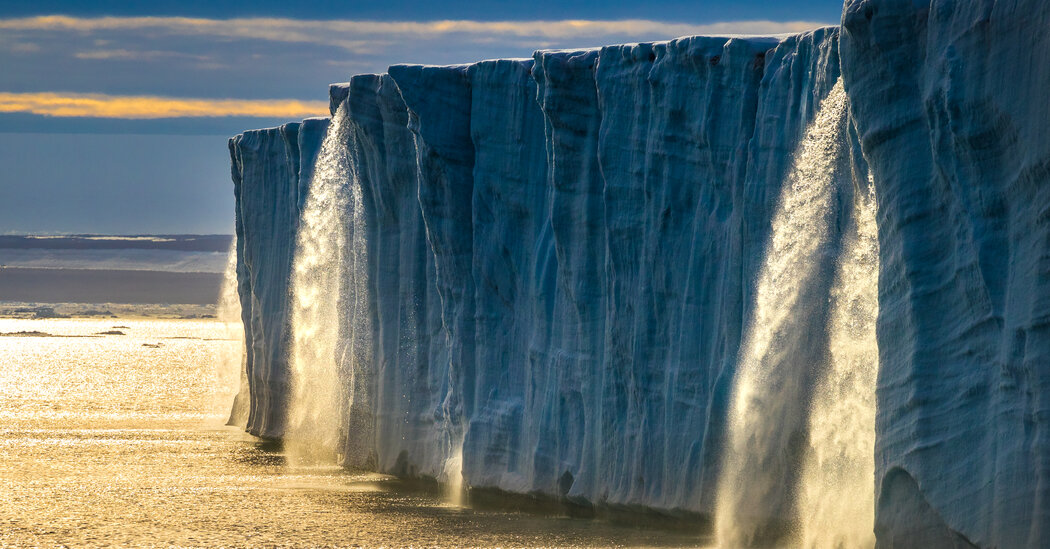
Mesmerized, I would lean against the railing at the front of the ship, alone, for hours on end. Over the course of 10 days, no two moments were the same. The Arctic world was constantly shifting and changing around me as we slowly made our way through ice and open sea, past whales, walruses, birds and bears.
Except to keep track of mealtimes, watches were irrelevant; in the summer, this far north of the Arctic Circle, the sun never goes anywhere near the horizon.
And yet Svalbard, though seemingly timeless, is perhaps the closest thing we have to a ticking clock.
I visited the Norwegian archipelago of Svalbard in 2017, having ended up on the M/S Stockholm, a classic ship built in 1953 and refitted in 1998, through sheer luck. (A last-minute cancellation and a chance meeting with a South African dentist somehow got me a closet-size cabin.) I stepped aboard, excited but without any particular expectations.
With a population of around 2,400 people, Longyearbyen is the archipelago’s largest settlement. It is a decidedly quirky place. Named after an American mine owner, John Munro Longyear, the town is home to a mostly dismantled coal-mining industry, a university campus, a global seed bank and a small but thriving tourism industry that’s focused almost exclusively on Svalbard’s natural beauty.
Viewed from the sea, Svalbard seemed to be the very epitome of wilderness: a vast expanse of largely untouched water, ice and islands, free from human habitation and infrastructure, aside from the occasional passing boat. This, of course, was why I was unable to tear myself away from the deck, wolfing down meals and sleeping as little as possible.
I have always been drawn to open spaces — deserts, mountains, grasslands. The sea is categorically different, moving around us even when we try to remain still. Watching ice drift past through thick fog, waterfalls gush down the sides of giant glaciers, or the sky perfectly reflected in suddenly still water, it was hard to shake the feeling that this was somehow both ethereal and eternal.
Unfortunately, climate change all but guarantees an eventual (and probably fairly imminent) collapse of what is, in fact, an exceptionally fragile ecosystem. The 29 national parks and other protected areas that cover two-thirds of the Svalbard archipelago can protect its wild inhabitants from hunting and pollution, but not from increasing water and air temperatures. Every year brings us further news of ever-shrinking glaciers and reduced ice cover — ice upon which the 3,000 polar bears who live in the Svalbard archipelago and Barents Sea depend for their survival.
“The map has been completely redrawn during my time here,” said Fredrik Granath, an author, photographer and expedition leader who has 20 years of experience working on Svalbard. “Routes we used to travel on foot or by snowmobile only 10 years ago are now accessible only by boat. It gets worse every year.”
Tourism, as is so often the case, finds itself being simultaneously part of the problem and part of the solution. On the one hand, air travel is a significant contributor to climate change, accounting for about 2.5 percent of global carbon dioxide emissions. (The travel industry as a whole has a footprint estimated between 8 and 11 percent of total greenhouse gases, according to the World Travel & Tourism Council.) Choosing to fly less is undoubtedly important, especially since global airplane emissions of carbon dioxide are expected to triple by 2050.
On the other hand, tourism can be an invaluable conservation asset. In many parts of the world, wild places remain wild in large part because of tourism’s ability to provide jobs and revenue, allowing conservation to compete financially with farming, mining and logging. Though far from perfect, a subset of the travel industry can and does fund research, anti-poaching patrols and community development. It also means that there are people — locals, visitors, journalists — who can bear witness, spread awareness, raise funds and, sometimes, dedicate their lives to a cause that touched them.
“You cannot describe the brutality of what is happening with images or words alone,” Mr. Granath says. “Svalbard is at a tipping point. Some people need to experience it first hand, or this incredibly important story will unfold unseen.”
All of this passed through my mind as the M/S Stockholm continued its journey on the Arctic Ocean. Moments of breathlessness from the overwhelming beauty would be followed by others provoked by grief at the prospect of its disappearance, of a future where healthy polar bear populations and thriving Arctic ecosystems are only memories.
For better or worse, Svalbard’s future will not be decided locally. With persistence and luck, though, continued glimpses into the Arctic world — whether through our own experiences or those of others — will keep chipping away at the resistance to properly safeguard this planet’s remaining wild places.



